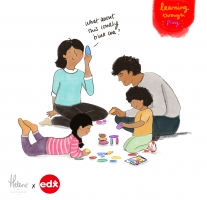Safety in Educational Toys
What’s important when purchasing online
The issue of safety in children’s toys is so important with ever-expanding internet shopping, where more and more purchases are taking place directly with online retailers and manufacturers.
Over the past 12 months, there has been an increase in toys that do not meet safety standards, sold through third-party sellers in both the UK and the US. These are sparking an increase in concern from parents, and from trustworthy retailers and manufacturers, and various organisations including The British Toy and Hobby Association (BTHA), Royal Society for the Prevention of Accidents (RoSPA), and the United States Consumer Product Safety Commission (CPSC).
Play is not risk-free – and nor should it be – but we can control most of the hazard’s children are exposed to. Toys must be safe by law, but how they are used, and the age of the child are important factors in preventing accidents. RoSPA
BTHA believes that online marketplaces should owe a duty of care to their customers to ensure that all toys that are available to purchase via their platforms are safe. They have campaigned for more than a year to remove increasing numbers of unsafe toys from the UK marketplace.
Shockingly, over the past year of testing toys safety, the BTHA found 86% of the toys purchased were illegal to sell in the UK as they failed to comply with the UK toy safety requirements and 60% were unsafe for a child to play with. The BTHA has concerns about the lack of accountability of online marketplaces for the sales of toys by third-party sellers.
Edx Education has been researching how consumers can make more informed decisions when buying toys.
Buy from suppliers with a good reputation for safe and reliable toys. Many will be members of trade associations whose rules call on them to meet high standards. If buying toys from a jumble sale or car boot sale, extra care needs to be taken.
Avoid buying from third-party sellers on online marketplaces – you will be able to tell by looking at the marketplace receipt if it is a third-party, rather than the company who makes the toy. Make sure that any reviews you read are not computer generated and note that the cheapest price may mean it’s a counterfeit product that will not be made to the same standards.
Research before you buy; if you are buying from a marketplace, look for the company logo on their marketplace page. Always add the company that makes the toy into your search.
All of Edx Educations products on Amazon clearly state our name in the title and this will show up in searches.

Check for an EU, US or UK address from the seller, and once you receive the toy, the packaging should look genuine with good quality print, and of course check for a CE mark (or a UKCA mark going forward).
Don’t assume that any safety tests have been carried out. Stay with your child when they open a toy for the first time to check there are no faults, toxic art materials in crayons and paints sets, access to stuffing from stuffed toys, and most importantly loose or accessible batteries or magnets which can be swallowed.
Look for small parts that could come away easily and be a choking hazard. If a toy breaks for any reason, throw it away as sharp bits of plastic toys can cause injury. Wooden toys are generally well-made but can still be broken or thrown, causing trips to emergency departments.
Make sure the toys are suitable and read warning labels. Some children, particularly those under three, should avoid toys with small parts to cut the risk of choking. It should also be remembered there will be significant differences in the abilities of those in the same age group and those children with special needs.
At RoSPA, they have been working towards a vision for life, free from serious accidental injury, since 1916.
Here are their top 10 safety tips for safety in children’s toys:
- Buy toys only from reputable outlets – look for the CE symbol
- Make sure the toy is suitable for the child – check the age range
- Be particularly careful with toys for children under three
- Be wary of a young child playing with older children’s toys
- Check for loose hair and small parts, sharp edges and points
- Ensure that outdoor toys like garden swings and slides are robust and are not a strangulation hazard
- Check toys regularly for wear and repair or dispose of them where necessary
- Keep play areas tidy
- Follow the instructions and warnings provided with toys
- Supervise young children at play
As a quality educational manufacturer, there are many safety guidelines that Edx Education adhere to, keeping the highest certifications with our products and company (from CE, ASTM, CPSIA, ISO9001, ISO14001 and so many more.) We fully agreed with the BTHA calling on the government to take steps now to ensure a child is not seriously hurt or killed by an unsafe toy.
Learning Through Play with Edx Education: hands-on learning experiences, award-winning toys, home learning activities, downloadable resources, educational play ideas and advice, and so much more…
There are more than 40,000 toy-related injuries each year, but toy safety is only part of the problem. Many accidents involving toys occur when people trip over them and when babies play with toys intended for older children, so it pays to always be vigilant at home and in the garden to help stop avoidable accidents.
Play, learn and create! And stay safe.
Edx Education – Heather Welch
To find your local Edx Education retailer head over to Where to buy – Edx Education.


